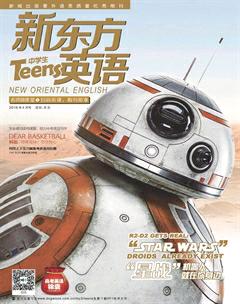肯尼斯·志之冢:守护老年痴呆症患者的暖心少年
老年痴呆症患者可能会出现随意走动的症状,如果没有被家人或看护者及时发现,他们就很容易走丢或是发生意外,甚至还会有生命危险。为了让患有老年痴呆症的姥爷不再走丢,一位名叫肯尼斯·志之冢的美国少年设计出了一款可穿戴式运动传感器,不仅为他的姥爷,更为广大老年痴呆症患者送去了“平凡”而又温暖的守护……
Kenneth Shinozuka was six when a policeman brought his grandfather home, who'd been wandering the freeway in his pajamas.
His grandfather had always been there for Kenneth, reading and singing to him and taking him for walks on the beach. Now his grandfather needed help. Getting lost wasn't the first sign he had Alzheimer's, but it was the most dramatic. Kenneth vowed to do everything he could to protect his beloved grandpa. He invented a motion sensor that sends a signal to a caregiver's smartphone when a patient steps out of bed.
More than 5 million Americans have Alzheimer's and every 67 seconds someone in the U.S. develops the disease, according to the Alzheimer's Association. The disease takes its toll on2) 15.5 million caregivers, burdened with the stress of caring for a loved one with the disease. Sixty-five percent of all Alzheimer's patients wander, according to the association. Kenneth's aunt, who has a PhD in pharmaceutical3) science, had to quit her job as a professor to care for his grandfather, Kenneth's mother said in an interview.
Kenneth got the idea for a motion sensor one night when he was watching his grandfather and he started to get up to wander.
"As soon as he stepped onto the floor, I had this sort of light bulb moment, sort of a eureka4) moment."
肯尼斯·志之冢六岁时,有一次一位警察把他的姥爷送回了家,此前穿着睡衣的姥爷一直在高速公路上四处游荡。
肯尼斯的姥爷曾经一直陪伴在他的身边,给他读书、唱歌,还带他到海滩去散步。现在,姥爷需要帮助了。虽然走丢并不是他患上老年痴呆症的首个症状,但却是最让人揪心的。肯尼斯发誓要尽所能保护心爱的姥爷。他发明了一款运动传感器,它可以在患者下床时向看护者的智能手机发送信号。
美国老年痴呆症协会表示,美国有超过500万的老年痴呆症患者,而且每67秒就有一位美国人患上老年痴呆症。这种疾病为1550万看护者带来了不小的麻烦,他们承受着照料患有该疾病的亲人的压力。协会还称,在所有老年痴呆症患者中,有65%的人都会到处乱走。肯尼斯的妈妈在一次采访中说,肯尼斯的姨妈是一位拥有药物科学博士学位的教授,为了照顾肯尼斯的姥爷,她不得不辞去了自己的工作。
一天晚上,肯尼斯注视着姥爷,姥爷则开始起身要走动,就在那时,肯尼斯想到了运动传感器这个点子。
“他的脚刚一踏上地板,我就突发灵感,就是‘我发现了!的那种瞬间。”
Kenneth's motion sensor attaches to a sock or the bottom of a foot. In a TED5) Talks appearance, Kenneth said he faced three challenges in developing the sensor. First, he needed to come up with a material that was thin enough to be comfortable on the bottom of a foot. He tried rubber but quickly ruled it out6) because it was too thick. He decided to use film7) with electrically conducted pressure-sensitive8) ink particles. Once pressure is applied, the particles move closer together, starting the signal.
Next, he had to design a wearable wireless circuit, but a wireless signal transmission requires heavy bulky9) batteries, Kenneth said. He used Bluetooth energy technology, which consumes very little power and can be driven by a coin-sized battery. Finally, he had to write code for an app that would transform a smartphone into a remote monitor. That required watching YouTube videos and reading textbooks, he said.
He sometimes got discouraged when he was working on the motion sensor, but his family's struggles prodded10) him not to give up. "The safety risks that wandering imposed on my grandfather definitely motivated me to continue working on the device even when I had hit a hard spot," Kenneth said in an interview.
In August, 2014, Kenneth, 16, received a $50,000 Scientific American11) magazine Science in Action Award for inventing the motion sensor.
One of the biggest rewards, Kenneth says, is that now his aunt, his grandfather's primary caregiver, can sleep at night. And his grandfather is no longer wandering, a dangerous habit that can result in death, Kenneth says. There have been no slip-ups12) in the motion sensor for 15 months.
肯尼斯的运动传感器可以贴在袜子上或是脚底。在TED大会的一次演讲中,肯尼斯说自己在设计传感器时遇到了三个挑战。首先,他需要找到一种足够轻薄的材料,这样穿在脚底才会觉得舒服。他尝试过橡胶,但很快就将其排除了,因为橡胶太厚了。他决定使用一种带有压敏油墨粒子的薄膜,这种油墨粒子可以通电,一旦受到挤压就会聚拢,从而产生信号。
接下来,他需要设计一个可穿戴的无线电路,但无线信号传输要用笨重的电池,肯尼斯说。他使用了蓝牙能源技术,这种技术只需耗费极少的电量,能由一枚硬币大小的电池所驱动。最后,他需要写代码编一个手机应用软件,从而用这个应用软件将智能手机变为一个远程的监测器。这就需要观看YouTube上的一些视频并阅读一些教材,他说。
在研制运动传感器的过程中,他有时也会感到灰心丧气,但家人的种种挣扎和努力督促他不要放弃。肯尼斯在一次采访中表示:“姥爷到处乱走所带来的安全风险确确实实激励我即使遇到困难也要继续研究这个设备。”
2014年8月,16岁的肯尼斯因发明运动传感器获得了由《科学美国人》杂志颁发的奖金为50000美元的“科学实践奖”。
肯尼斯称,最大的回报之一便是姥爷的主要看护者他的姨妈现在终于可以在晚上安心睡觉了。而姥爷则没有再到处乱走了,这一危险的习惯可能会导致死亡,肯尼斯说。15个月来,这款运动传感器都没有出过任何差错。
1. Alzheimer's: (又作Alzheimer's disease)阿尔茨海默氏病,早老性痴呆病
2. take its toll on: 造成损失(或危害、伤亡等)
3. pharmaceutical [?fɑ?m??su?t?kl] adj. 制药的
4. eureka [ju?ri?k?] int. 我发现了!(相传是阿基米德根据比重原则测出金子纯度时所说的话;现用作有重大发现时所说的惊叹语)
5. TED: (= Technology, Entertainment, Design)由美国一家非营利性机构幼苗基金会(Sapling Foundation)所运营的世界性大会,诞生于1984年,其宗旨是“值得传播的创意(Ideas Worth Spreading)”。该大会邀请科学、设计、文学、音乐等众多领域的杰出人物,分享他们关于科技、社会、自然和人类等方面的思考和探索。
6. rule ... out: 把……排除在外;排除……的可能性
7. film [f?lm] n. 薄层;薄膜
8. pressure-sensitive [?pre??(r)?sens?t?v] adj. 对压力敏感的,压敏的
9. bulky [?b?lki] adj. 又大又笨的,不灵巧的
10. prod [pr?d] vt. 督促
11. Scientific American: 《科学美国人》杂志,美国的一本科普杂志,创刊于1845年,是美国历史最长且一直连续出版的杂志。
12. slip-up [?sl?p?p] n. 差错;疏忽
13. civil engineering: 土木工程(学)
14. take it upon oneself to do ...: 自行决定做……
15. Bronx: 布朗克斯区,是美国纽约的一个区。
16. critique [kr??ti?k] vt. 给……写评论;对……发表评论
"He Knows the Struggles of the Elderly."“他了解老年人的艰难。”
Kenneth is the only child of two civil engineering13) professors at Columbia University in New York City. He lived his first 13 years in Newport Beach, California, where his parents were the principal caregivers for his grandfather. His grandmother also lived with them. The first sign of his grandfather's Alzheimer's came when they were vacationing in Japan and his grandfather took him for a walk in a park and got lost. His mother found them after about half an hour.
"Kenneth got really scared," Kenneth's mother said. "He was four years old."
Kenneth took it upon himself to make14) life safer for his grandfather. When he was six and in kindergarten, an elderly friend of the family fell in the bathroom and was injured and badly burned. Worried about his grandfather, Kenneth came up with a "smart bathroom". Motion sensors would be installed in the bathroom tiles to detect a fall. When he was seven and his grandfather started having trouble remembering what medicine to take, Kenneth thought up the "smart medicine box" that would use sensors to tell a patient what medicines to take.
Both ideas received first place awards in the Outstanding Inventions contest held each year at Irvine Valley College in Irvine, California, for elementary through high school students.
"He's very close to his grandfather," his mother said. "He knows the struggles of the elderly."
Kenneth and his grandfather share a love of singing. Kenneth sings a special song to his grandfather, who sometimes remembers and can sing along. It's about a road in China and seeing off an old friend.
"It's a song that my grandfather taught me when I was very young," Kenneth said. "And in order to keep his memory alive I sing back to him the same song that he taught me when I was growing up."
Kenneth and his family moved to Manhattan two-and-a-half years ago. He's a junior at Horace Mann School in the Bronx15).
Kenneth says he doesn't have much spare times these days, but what he has he spends on a wide array of activities. He's editor-in-chief of Cinemann Magazine, a school publication, and critiques16) movies at his own website, oneminutereviews.org.
肯尼斯是家中的独子,父母都是纽约市哥伦比亚大学土木工程学的教授。从出生一直到13岁,他都生活在加利福尼亚州的纽波特比奇市,当时他的父母是他姥爷的主要看护者,他的姥姥也和他们生活在一起。姥爷首次出现老年痴呆的症状时,他们一家人都在日本度假,姥爷带着他去一个公园散步,却迷了路。他的妈妈过了大概半个小时才找到他们。
“肯尼斯真的吓坏了,”肯尼斯的妈妈说,“那时他才四岁。”
肯尼斯自己决意要使姥爷的生活更加安全。当他六岁在上幼儿园时,他们家一位年长的朋友在卫生间摔倒并受了伤,还被严重地烫伤了。肯尼斯非常担心姥爷,于是便发明了一个“智能卫生间”。卫生间的地砖上会装上许多运动传感器,用来监测是否有人摔倒。在他七岁时,姥爷开始记不清应该吃什么药了,肯尼斯就发明了“智能药箱”,它会利用传感器来告诉病人该服用什么药。
肯尼斯的这两项发明都获得了加利福尼亚州欧文市欧文河谷学院举办的年度“杰出发明竞赛”(面向小学生及初、高中生)的一等奖。
“他和姥爷特别亲,”他妈妈说,“他了解老年人的艰难。”
肯尼斯和姥爷都喜欢唱歌。肯尼斯经常唱一首特别的歌给姥爷听,姥爷有时会记得这首歌,还会跟着他一起哼唱。那首歌是关于中国的一条古道以及送别一位老友的。
“这是我很小的时候姥爷教给我的一首歌,”肯尼斯说,“为了保持他的记忆力,我长大后又把他教我的这首歌唱给他听。”
肯尼斯和家人在两年半前(编注:英文原文发表于2015年3月)搬到了曼哈顿。他现在在布朗克斯区的贺拉斯曼中学读高三。
肯尼斯说自己最近没有多少空闲时间,但只要一有时间他就会用来参加各种各样的活动。他在校刊《爱影人杂志》担任主编,还在自己的网站oneminutereviews.org上面撰写影评。

